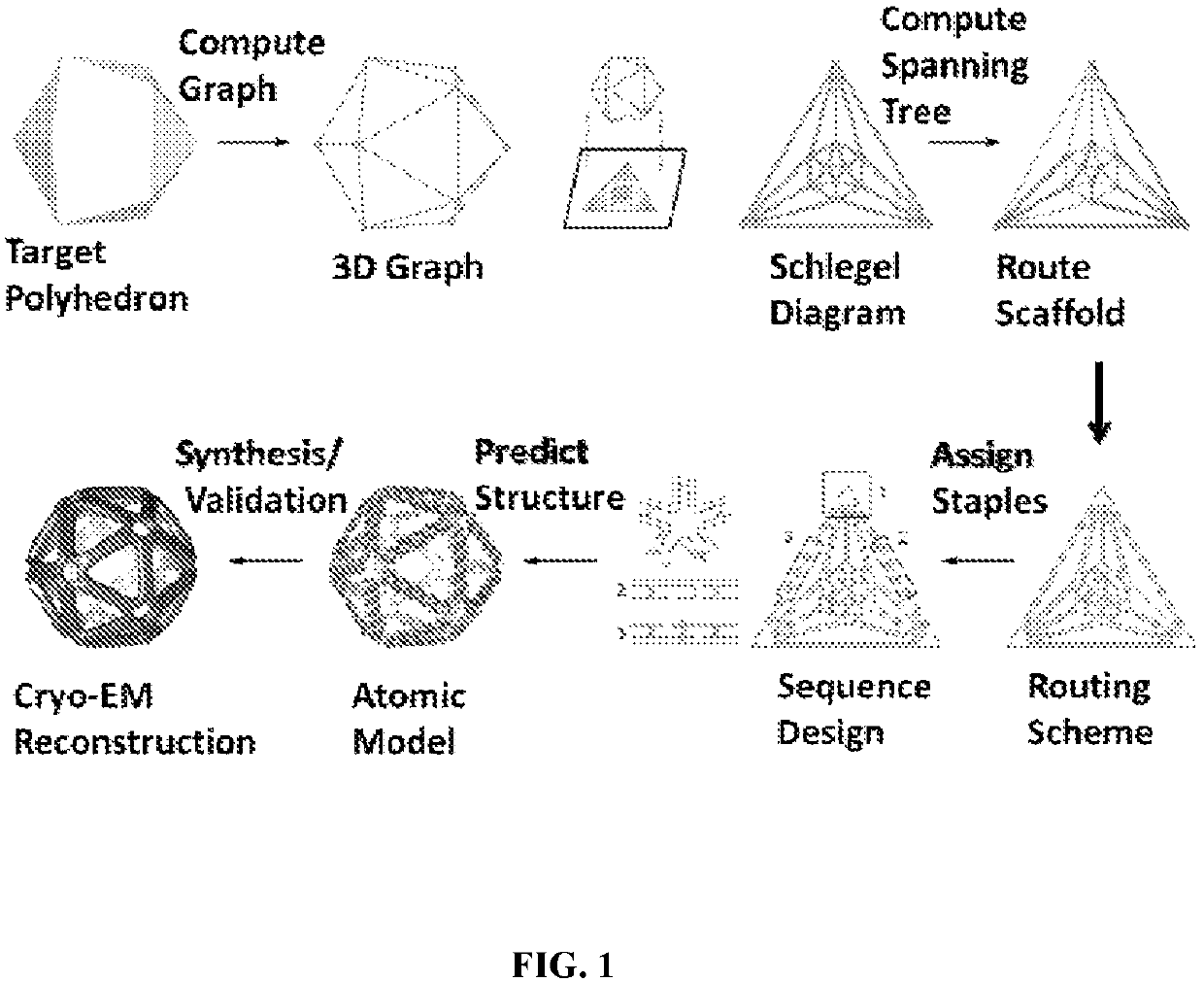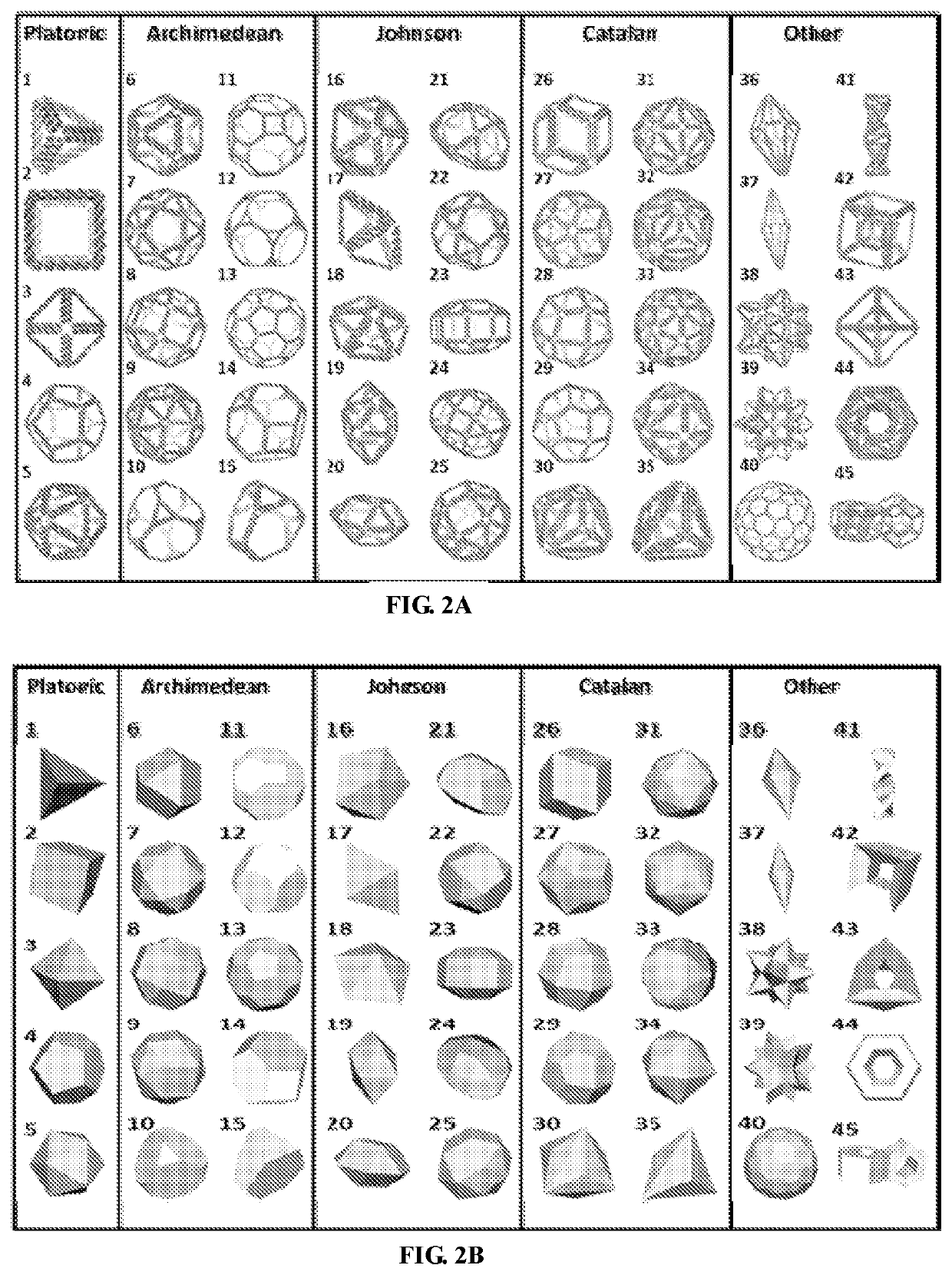Stable nanoscale nucleic acid assemblies and methods thereof
a technology of nano-scale nucleic acids and assemblies, applied in the direction of ict adaptation, instruments, molecular structures, etc., can solve the problems of unstable and conforming assemblies that are unsuitable for many applications, and limit the scope of the assembly
- Summary
- Abstract
- Description
- Claims
- Application Information
AI Technical Summary
Benefits of technology
Problems solved by technology
Method used
Image
Examples
example 1
omatic and Robust Inverse Design of Programmed DNA Assemblies
[0491]Structure-based, rational design of macromolecular assemblies including both nucleic acids and proteins is a long-standing aim of nanotechnology and biological engineering. Unlike proteins, which contain a myriad of specific and non-specific inter-residue interactions that determine their local and global folds, and RNA, which exhibits promiscuity in secondary structure and base-pairing, synthetic DNA assemblies are well established to be highly programmable using Watson-Crick base pairing alone (Seeman, et al., Biophys. J. 44, 201-209 (1983); Rothemund, P W K, Nature, 440, 297-302 (2006)). In particular, wireframe polyhedral geometries offer the powerful ability to program nearly arbitrary 3D geometries on the nanometer scale, limited only by current size constraints imposed by single-stranded scaffold lengths. This important and versatile class of topologies therefore has broad potential for programming complex nan...
example 2
d Inverse Design of Programmed DNA Assemblies with Modified Geometry
Methods and Materials
[0538]To create nanostructures having modified geometry at the edges and vertices, parameters specifying both the number of nucleic acid helices and cross-sectional geometric pattern are input. A modified and enhanced procedure related to the methods described in Example 1 is carried out to specify scaffold routing throughout the desired geometry at each edge of the nanostructure. In addition, the geometry of each vertex can be defined as being flat (i.e., non-beveled) or having beveled edges, to accommodate the cross-sectional geometry of each edge as it enters and leaves the vertex.
[0539]Modifying Geometry
[0540]To route a single-stranded scaffold throughout the entire geometry with edges formed from 6 double helices arranged in honey-comb morphology (6 HB edges), geometric manipulation to generate six-lines per each edge is carried out. Each edge is detached from two vertices connected to it a...
example 3
Yield and Homogeneity of Self-Assembled DNA Origami Objects
Methods and Materials
[0567]Materials
[0568]Chemicals
[0569]Tris-Acetate-EDTA buffer, MgCl2, NaCl, TRIS-base, and nuclease-free water were purchased from Sigma-Aldrich. The Zymoclean gel DNA recovery kit was purchased from Zymo Research, Inc. and the Amicon Ultra-0.5 mL centrifugal filter (MWCO 100 kDa) from EMD Millipore, Corp. Restriction enzymes and the DNA ladder (Quick-Load® Purple 2-Log DNA ladder 0.1-10 kb) were provided by New England Biolabs, Inc. (NEB), the PCR enzyme (Accustart® Taq DNA polymerase HiFi) by Quanta Bioscience, Inc., low melt agarose by IBI Scientific, Inc., Seakem® agarose by Lonza Group, Ltd., and SYBR Green (10000×) by Thermo Fisher Scientific, Inc.
[0570]Oligonucleotides and DNA Templates
[0571]M13mp18 single-stranded DNA scaffold as well as the Lambda DNA was provided by NEB. (N4040S, N3011S). All oligonucleotides (for DNA assembly, asymmetric PCR, and scaffold digestion) and double stranded DNA gBlo...
PUM
| Property | Measurement | Unit |
|---|---|---|
| melting temperature | aaaaa | aaaaa |
| melting temperature | aaaaa | aaaaa |
| temperature | aaaaa | aaaaa |
Abstract
Description
Claims
Application Information
 Login to View More
Login to View More - R&D
- Intellectual Property
- Life Sciences
- Materials
- Tech Scout
- Unparalleled Data Quality
- Higher Quality Content
- 60% Fewer Hallucinations
Browse by: Latest US Patents, China's latest patents, Technical Efficacy Thesaurus, Application Domain, Technology Topic, Popular Technical Reports.
© 2025 PatSnap. All rights reserved.Legal|Privacy policy|Modern Slavery Act Transparency Statement|Sitemap|About US| Contact US: help@patsnap.com



